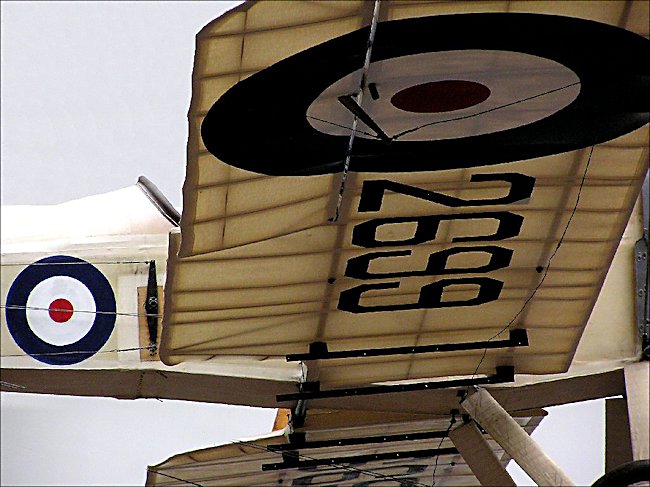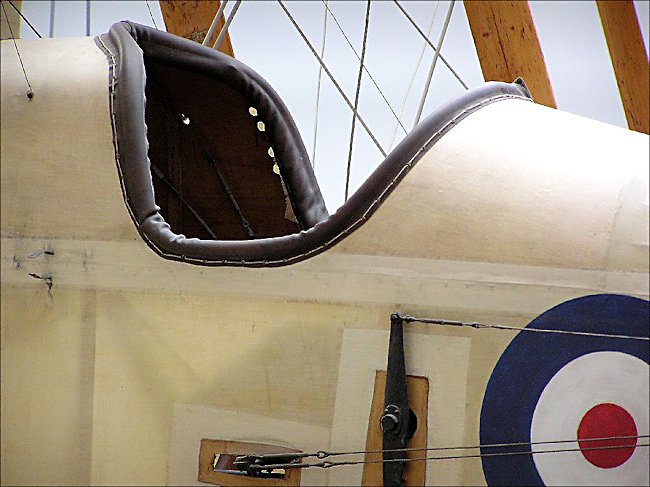Royal Aircraft Factory BE2c Biplane
Before the outbreak of World War One in 1914 the British Army believed that the main use of these new flying machines was for artillery observation and intelligence reconnaissance. It had been designed as a highly stable observation platform that could fly straight and level. It was not designed to be manoeuvrable. The invention of a purpose made fighter aircraft with greater speed and agility had not been conceived at that time. Dog fighting had not occurred to the generals at this stage of the war. F1 stood for fighter one
German fighter pilots called the BE2's 'kaltes Fleisch' (cold meat) BE2's were easy targets. The British press to dub the BE2 "Fokker Fodder". The first RFC aircraft deployed to France were a mixture of BE2's of No 2 and 4 Squadrons, Bleriot monoplanes and Farmans of No 3 Sqn and Farmans, Avro 504s and BE8s of No 5 Sqn.
The Royal Aircraft Factory developed the BE light bomber Biplane between 1911 and 1914 but the Royal Flying Corps ordered them to act as reconnaissance aircraft. It was the first aircraft to be designed purely for military use. The Royal Aircraft Factory BE2 was a two-seater which became one of the longest serving and multi-functional aircraft of the first world war even though it was criticized for its rear pilot's cockpit, limited gunners space with obscured view because of the wing and engine problems. The BE2 was capable of reaching 10,560 feet and could carry a load of 450 pounds. It could climb to 10,000 feet at a rate of 365 feet per minute and could reach speeds of 70mph. Eight variants of the BE2 were created which increased the aircraft's longevity and resulted in a continuation of aircraft design. These were called BE2, the BE2a, BE2b, BE2c, BE2d, BE2e, BE2f and the BE2g.

Photograph taken at the RAF Museum, Hendon, London NW9 5LL England
Geoffrey de Havilland was a 29-year old designer at His Majesty's Balloon Factory when His Majesty's War Office realized it needed to pay attention to heavier-than-air flight. They found a wrecked Voison aeroplane. De Havilland and chief engineer Major F.M Green used pieces from these planes to create a new flying machine. The result was a biplane with a long slender body, two large wings set far apart, four-bladed propeller, double cockpit, and a long-legged landing gear. De Havilland had never seen a plane in flight. This was more robust that what had gone before. Gone was the flimsy box-kite look of the first planes.
The letters BE stand for "Bleriot Experimental" aircraft as it was a variation on Louis Bleriot designs. Gabrial Voisin had bought out Louis Bleriot and established a company called Appareils d'Aviation Les Freres Voisin (Voisin Brothers' Flying Machines) making machines based on Louis Bleriot design. The BE1 made its first flight in early December 1911. It was surprisingly quite. Ideal for reconnaissance work. It was underpowered so a 70hp Renault in-line engine was fitted to replace to the 60hp version. This new version was renamed the BE2. Increasing its maximum speed from 69 mph to 75mph at sea level. It was also fitted with a radio and used to control an artillery barrage during an exercise on Salisbury Plain in England.

Photograph taken at the RAF Museum, Hendon, London NW9 5LL England
The letters BE stand for "Bleriot Experimental" aircraft as it was a variation on Louis Bleriot designs. Gabrial Voisin had bought out Louis Bleriot and established a company called Appareils d'Aviation Les Freres Voisin (Voisin Brothers' Flying Machines) making machines based on Louis Bleriot design. The BE1 made its first flight in early December 1911. It was surprisingly quite. Ideal for reconnaissance work. It was underpowered so a 70hp Renault in-line engine was fitted to replace to the 60hp version. This new version was renamed the BE2. Increasing its maximum speed from 69 mph to 75mph at sea level. It was also fitted with a radio and used to control an artillery barrage during an exercise on Salisbury Plain in England.
BE2s were used in the Middle East and for Anti-submarine patrols. By 1915, it's lack of maneuverability and restricted field of fire from the observer's front cockpit, made it vulnerable by the new German Fokker Eindecker Monoplanes. The need to defend reconnaissance aircraft was recognised in 1915 and squadrons were assigned a small number of Bristol Scouts to act as escorts. Once the threat from the Fokker monoplanes was contained by the availability of allied escort fighters such as the Airco D.H.2, Nieuport 11 and Royal Aircraft Factory F.E.2, B.E.2c losses over the Western Front dropped to an acceptable level, with official records indicating that in the second quarter of 1916, the B.E.2 actually had the lowest loss rates of all the major types then in use.

Photograph taken at the RAF Museum, Hendon, London NW9 5LL England
Encouraged by this, the RFC took delivery of large numbers of the BE.2e, which promised improved performance. By the Spring of 1917, however, conditions on the Western Front had changed again, with the German fighter squadrons re-equipped with better fighters such as the Albatross D.III. Although it had been planned to replace the B.E.2 in front-line service by this time with the Armstrong Whitworth F.K.8 and Royal Aircraft Factory R.E.8, deliveries of these types was slower than hoped. This culminated in what became known as "Bloody April", with the RFC losing 60 B.E.2s during that month.
Photograph taken at the RAF Museum, Hendon, London NW9 5LL England
Gradually they were withdrawn to England to protect against Zepplin raids. BE2s shot down five German Zeppelin Airships. The "interceptor" version of the B.E.2c was flown as a single-seater with an auxiliary fuel tank in the observer's seat position. After an initial lack of success attack Zeppelin airships from above using darts and small incendiary bombs a Lewis gun was mounted to fire incendiary ammunition upwards, at an angle of 45 degrees. This modification and change of tactic worked. The first successful attack took place on the night of 3 September 1916, when a B.E.2c flown by Captain William Leefe Robinson downed the first German airship to be shot down over Britain, winning him a Victoria Cross and cash prizes totaling £3,500 that had been put up by a number of individuals for the first Zeppelin kill over the British Isles. Five more German airships were destroyed by Home Defence B.E.2c interceptors between October and December 1916.
BE2c Fighter books


Tweet